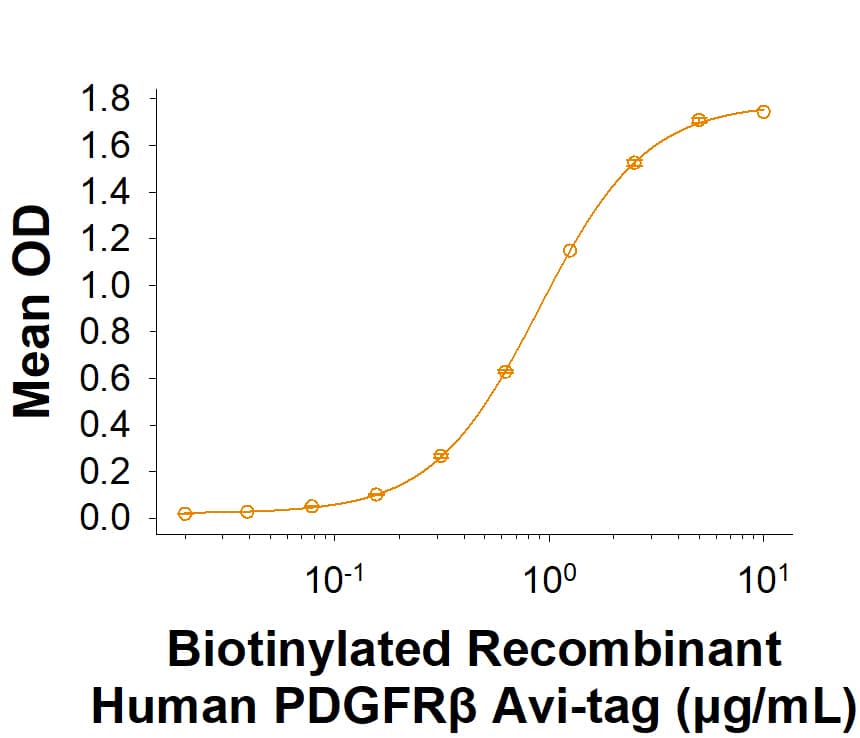Recombinant Human PDGF R beta His-tag Avi-tag Protein, CF
R&D Systems, part of Bio-Techne | Catalog # AVI10676

Key Product Details
Source
HEK293
Accession #
Structure / Form
Biotinylated via Avi-tag
Conjugate
Biotin
Applications
Bioactivity
Product Specifications
Source
Human embryonic kidney cell, HEK293-derived human PDGF R beta protein
Leu33-Lys531, With a C-terminal 6-His tag & Avi-tag
Leu33-Lys531, With a C-terminal 6-His tag & Avi-tag
Purity
>95%, by SDS-PAGE visualized with Silver Staining and quantitative densitometry by Coomassie® Blue Staining.
Endotoxin Level
<0.10 EU per 1 μg of the protein by the LAL method.
N-terminal Sequence Analysis
Leu 33
Predicted Molecular Mass
59 kDa
SDS-PAGE
100-110 kDa, under reducing conditions
Activity
Measured by its binding ability in a functional ELISA.
Biotinylated Recombinant Human PDGFR beta His-tag Avi-tag binds to Recombinant Human PDGF-BB Protein (Catalog # 220-BB) with an ED50 of 0.150-1.50 μg/mL.
Biotinylated Recombinant Human PDGFR beta His-tag Avi-tag binds to Recombinant Human PDGF-BB Protein (Catalog # 220-BB) with an ED50 of 0.150-1.50 μg/mL.
Scientific Data Images for Recombinant Human PDGF R beta His-tag Avi-tag Protein, CF
Biotinylated Recombinant Human PDGF R beta His-tag Avi-tag Protein Binding Activity.
Measured by its binding ability in a functional ELISA. Biotinylated Recombinant Human PDGFR beta His-tag Avi-tag Protein (Catalog # AVI10676) binds to Recombinant Human PDGF-BB Protein (220-BB) with an ED50 of 0.150-1.50 μg/mL.Biotinylated Recombinant Human PDGF R beta His-tag Avi-tag Protein SDS-PAGE.
2 μg/lane of Biotinylated Recombinant Human PDGF R beta His-tag Avi-tag Protein (Catalog # AVI10676) was resolved with SDS-PAGE under reducing (R) and non-reducing (NR) conditions and visualized by Coomassie® Blue staining, showing bands at 100-110 kDa, under reducing conditions.Formulation, Preparation and Storage
AVI10676
| Formulation | Supplied as a 0.2 μm filtered solution in PBS. |
| Shipping | The product is shipped with dry ice or equivalent. Upon receipt, store it immediately at the temperature recommended below. |
| Stability & Storage | Use a manual defrost freezer and avoid repeated freeze-thaw cycles. |
Background: PDGF R beta
References
- Betshotz, C. et al. (2001) BioEssays 23:494.
- Ostman, A. and A.H. Heldin (2001) Advances in Cancer Research 80:1.
- Gilbertson, D. et al. (2001) J. Biol. Chem. 276:27406.
- LaRochells, W.J. et al. (2001) Nature Cell Biol. 3:517.
- Tiesman, J. and C.E. Hart (1993) J. Biol. Chem. 5:9621.
Long Name
Platelet-derived Growth Factor Receptor beta
Alternate Names
CD140b, PDGFRB
Gene Symbol
PDGFRB
UniProt
Additional PDGF R beta Products
Product Documents for Recombinant Human PDGF R beta His-tag Avi-tag Protein, CF
Product Specific Notices for Recombinant Human PDGF R beta His-tag Avi-tag Protein, CF
For research use only
